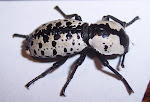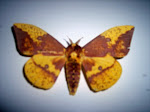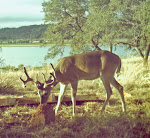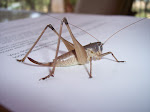January 15, 2010 Mockingbird
Good morning to you! Since I’m just sitting here waiting for my coffee to cool and the sun to come up, I guess it is a good time to figure out what wildlife to feature in this issue of “Our Creatures”.
Now, I prefer to research and write up some critter that is suggested to me by one of our neighbors here. This way it kind of ties us together in our mutual interest in the local animals that share our part of the Hill Country. A couple of possibilities come to mind but one candidate rises to the top of my list pretty quickly. It started a little while back with a comment by Jackie Kiehm up on Mystic Parkway. It so happens that on Jackie’s early morning walks, she noted that she heard a series of tweets, warbles, melodies, whistles and songs that was striking in its variety. If I’m not mistaken, she said that there were probably a dozen or more different sounds coming from the roadside brush and trees as she walked down the steep part of Puzzle Pass road toward Nandina Way. “What birds around here”, she wondered, “could make such a variety of beautiful sounds?” She then asked if I could investigate and perhaps write up an article on these creatures if I could figure it out. Always willing to accept this kind of challenge, I took up the task and launched my investigation. I’m not Sherlock Holmes, but this one looked too easy.
A quick walk one morning over Puzzle Pass was all I needed to confirm my suspicion, and John would be the first to agree. The most likely source for the noisy attention Jackie was receiving is the construction workers building the new Richard Heller home near the windmill. A medley of WOLF WHISTLES can come in an astounding variety and Jackie is a likely target for this attention. Clearly, as she was taking her morning walks, the carpenters were eating their breakfast burritos under the nearby oak trees and wanted Jackie to know she was appreciated. Case closed…. a no-brainer and elementary, you might say. However, in the interest of being politically correct, couldn’t there be some other answer? Isn’t there some other possible solution to this puzzle? Well, it turns out there is.
We have a bird in our neighborhood, which is really quite common, called the Northern Mockingbird. In fact, it has been our Texas State Bird since 1927.
(Kingdom; Animalia, Phylum; Chordata, Class; Aves, Order; Passeriformes, Family; Mimidae, Genus; Mimus, Species; M. polyglottos)
Most Americans, and certainly most Texans, will tell you that the Mocker has the prettiest song of any bird native to North America. Its’ song is actually a medley of the calls of many other birds. Each imitation is repeated two or three times and then immediately followed by other songs in quick succession, and Mockingbirds often have three or even four dozen songs in their repertoire. If you’re interested, the following link will take you to a website that has some recorded songs. Just scroll down to the Sounds category.
http://ibc.lynxeds.com/family/mockingbirds-thrashers-mimidae
Mockingbirds sing constantly during the spring mating season, often even at night (particularly if the male hasn’t found a mate yet), and it has been shown that female Mockingbirds prefer males with large repertoires. Throughout the summer and fall both sexes will sing to stake out their feeding territories and they have also been known to imitate other sounds that they hear, such as rusty hinges squeaking and dogs barking. Their imitations are so exact that scientists cannot distinguish them from the real thing with electronic analysis. They are noisy little critters but what a delightful addition to our neighborhood!
As if their singing wasn’t enough, their territorial displays make them the most noticeable bird in Texas. Their audacious behavior when an intruder is spotted is almost comical in its intensity. They will fly slowly around, then circle and dive on and intentionally harass other birds, dogs, cats or anything they deem an intruder on their turf. They will also land on the ground and prance toward any intruder with legs extended, showing off their bright white wing patches. They might not have the brightest coloration of our local birds, but they have the brightest personalities!
Their light grayish-brown back fades into a whitish breast and when their wings are folded you can see a touch of the two distinctive white bars that are flashed when they get excited. There are white feathers along the sides of their tail that can be flared as well.
Mockingbirds are slender bodied, medium sized songbirds about ten inches long. The wings are short and rounded and this makes the relatively long tail appear even longer in flight. Their heads are small and their long, thin bill has a hint of a downward curve.
These birds are frequently seen sitting high on poles and overhead utility lines. You might also spot them running or hopping over a freshly mowed lawn, but you do not often see them at feeders.
Mockingbirds eat a variety of insects, small vertebrates and fresh fruit and vegetables. (Their taste for the goodies from your hard-won garden is somewhat offset by the amount of insects that they eat, so you gardeners shouldn’t be too hard on them.)
Mockingbirds range throughout the whole of North America and are one of the few birds found in every kind of habitat, from desert to forest to city. They are found year round throughout Texas, and I’ll bet there are probably a few up on Puzzle Pass right now.
The next time I’m up there at the same time Jackie or one of our other gals are in the area taking a walk, I’ll listen closely. If the serenade I hear includes sounds like “Oye, Nena! Que pasa?”, I’ll know the source of the whistles probably wasn’t our wonderful Mockingbird after all.
Clay
Friday, January 15, 2010
Subscribe to:
Comments (Atom)














